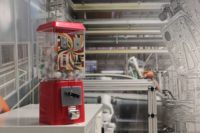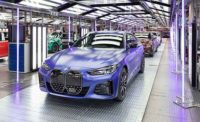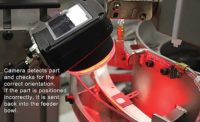Preparing existing automotive factories to assemble electric cars requires comprehensive modernization. Certainly, this was the case at Volkswagen’s assembly plant in Zwickau, Germany. Opened in 1990, the factory was completely converted to production of electric cars in 2019. It now assembles the Volkswagen ID.3 and ID.4, as well as the Audi Q4 e-tron. Volkswagen expects the plant eventually to churn out some 330,000 electric vehicles per year.
Dürr Systems Inc. played a major role in reconfiguring the plant to produce electric vehicles. The automation specialist designed and built several systems to ensure efficient assembly. Dürr provided input on every aspect of the assembly process, from the start of the line to the end-of-line test stands and the software for final assembly. The highlights of the system include:
- a flexible robotic system for dispensing adhesive onto side windows.
- an automatic screwdriving system for securing the battery pack.
- a modified filling system for various refrigerants.
- a conveyor adapted to the undercarriage geometry of the electric car platform.
The window installation process is now performed entirely automatically, including the feeding of front and rear windows from sequenced containers and side windows from type-specific containers; adhesive application; and insertion of the front and rear windows in cycle operation and the side windows in flow operation. Previously, automated insertion of side windows was only possible in stop-and-go mode.
In cooperation with Volkswagen, Dürr developed a new line-tracking process that keeps the bodies moving on skillet platforms while robots install the side windows. This reduced costs, since the conveyor did not have to be adapted to cycle operation. The new line-tracking technology will enable automakers to integrate the side window bonding system anywhere on an assembly line.
Dürr also developed an automated screwdriving system to install the battery back to the chassis. Each driver holds up to four screws in a magazine and fastens them one after other. With eight screwdrivers, the entire system installs 26 screws every minute.
Motor vehicle, Electrical wiring, Electronic engineering
Different refrigerants are used for climate control in the interior of the ID.3. Volkswagen is using the refrigerant R744 for the first time. The refrigerant’s thermodynamic properties mean it can be used for both cooling and heating. That saves energy, which, in turn, increases the car’s range. But, the new refrigerant required a new approach for the filling technology, since Volkswagen wanted to fill the vehicles with R744 in the same cycle time as the previously refrigerant. Dürr modernized the filling technology from the base unit to the adapters.
The pilot hall of the Zwickau factory has a 256-meter long section for overhead conveyors. In the past, 22 C-hangers with scissor lifts were used to transport car bodies on this line. However, these hangers were not compatible with the new undercarriage geometry of the electric vehicles, due to the high-voltage battery. Dürr replaced the C-hangers with four-arm hangers. Since bodies are no longer conveyed with wheels in the hanger, the project included a lifting platform for wheel assembly and the transfer operation.
To see the automated assembly process in action, click here: https://bit.ly/3jOQT5L.






